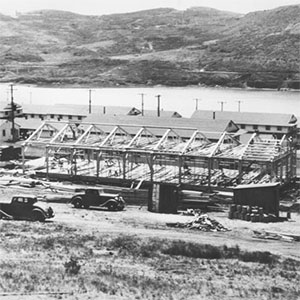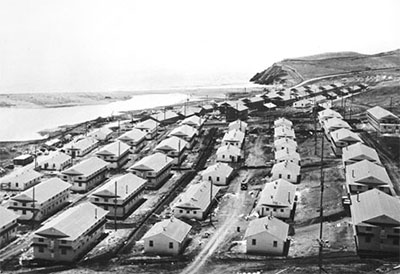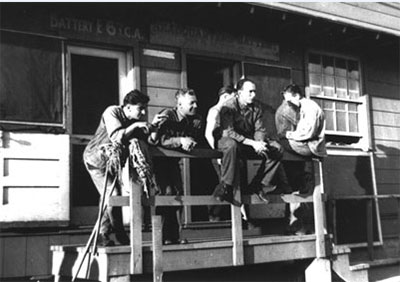Pre-War Mobilization on the West Coast

NPS
When war broke out in Europe in the fall of 1939, Americans were divided over whether to join the fighting and America tried to keep its men out of the fight as long as possible. However, the nation became pragmatic overtime about stepping into the fray if the situation in Europe didn’t improve. As a result, the United States became cautiously proactive about boosting efforts for wartime preparedness. After Germany invaded Poland, President Franklin Delano Roosevelt declared a limited state of emergency, which involved strengthening existing military posts and building new ones across the states. As diplomatic relations with Japan had deteriorated throughout the 1930s, the U.S. military especially wanted to strengthen their presence on the country’s west coast.
To protect the west coast from enemy attack, the army established the Harbor Defenses of San Francisco (HDSF.) Headquartered at the Presidio’s Fort Winfield Scott, the HDSF oversaw several San Francisco military posts and was responsible for defending against naval attacks, beach assaults and protecting friendly ships in its waters. Its jurisdiction protected a 60 mile span of coastline beginning north of Point Reyes and ending south of Half Moon Bay. Fearing an impending attack from the Japanese attack, the U.S. Army established Fort Cronkhite located in the Marin Headlands just north of San Francisco, as the last military post under the jurisdiction of the HDSF.
The Army’s Secret Weapon

NPS
In 1938, the army began secret construction on Battery Townsley, a casemated artillery battery to be installed a short distance above Fort Cronkhite. Battery Townsley would house the latest in naval defense: the massive 16-inch naval artillery gun, one of several such weapons to be installed in the region. Shortly after, Fort Cronkhite became the site of major military build-up. Men stationed at the fort were charged with manning the gun at Battery Townsley, a fifteen minute trek up the hill above their barracks at Rodeo Lagoon. Their duties involved repetitive drills and training concerned with operation of the 16-inch gun, a weapon that had never been fired. In the summer of 1940, the gun was ready for testing. The range of the gun’s 2,100 pound artillery shells was estimated at 25 miles. During the test firing, the gun exceeded this distance.
Housing the Soldiers

NPS
One of the key elements of the country’s prewar mobilization efforts was ensuring that the military could provide soldiers with adequate housing. In 1939, there were over 200,000 enlisted men in the U.S. Army; by 1940, due to a surge in drafted men and volunteer recruits, the number of enlisted men doubled. This dramatic increase in enlisted men intensified national focus on the armed forces and their required ability to provide adequate housing for their soldiers prior to their being sworn into service. Because Germany now occupied so much of Europe, the United States could not rely on European countries to house and train American soldiers prior to their deployment. As a result, the army’s Quartermaster Department and Corps of Engineers were now tasked with providing the critical housing and training facilities for hundreds of thousands of American soldiers, domestically.
The military designed standard building plans for quickly-constructed wood frame barracks, latrines, mess halls, offices and recreation buildings, that were soon constructed on military posts all across the country. These new facilities were built with five guiding principles in mind: speed, simplicity, conservation of materials, flexibility and safety. The army constructed these WWII barracks buildings at an incredible pace, made possible by pre-fabricated materials and a surplus of labor and resources. Construction crews from Fort Ord in Monterey boasted their ability to finish a building every 54 minutes. Fort Cronkhite was a prototypical example of these WWII era barracks that became ubiquitous across the U.S. military landscape.
Protecting the West Coast from Attack
The attack on Pearl Harbor on December 7th, 1941 shattered the monotonous barracks life at WWII posts around the country, especially on the west coast. Because many Fort Cronkhite soldiers were away on holiday leave on the day of the attack, radio announcements and newspaper advertisements called all Coastal Artillery servicemen back to their posts immediately. Pearl Harbor shifted the status of Fort Cronkhite from a training facility to one of military action. The HDSF was put on “A” alert, requiring the artillery guns to be actionable at a moment’s notice, 24 hours a day. The Fort Cronkhite soldiers manned Battery Townsley in 24-hour shifts. The soldiers slept and ate in makeshift bunks in the battery halls. Soldiers were also assigned to concrete look-out stations, imbedded in the hillsides overlooking the ocean. Manned with high-powered telescopes, the men scanned the dark ocean for signs of enemy ships. The winter of 1941-1942 was a trying time both mentally and physically for the men stationed at Fort Cronkhite, as they were required to endure severe wind, cold temperatures and rudimentary accommodations while remaining ever alert under the fear that an attack could occur any time.
By the fall of 1942, the alert status along the U.S. Pacific Coast was downgraded as the concern over an imminent attack from Japan dissipated. A new wartime routine developed, one with more relaxed regulations, allowing the men to return to the barracks at Fort Cronkhite. Soldiers stationed at bunkers and batteries were able to have visits from USO performers and “mobile canteens,” vendors that offered newspapers, treats and toiletries. By the end of 1942, as the tide of the war with Japan was beginning to turn to the Allies’ favor, the army began dismantling the Harbor Defense of San Francisco. The Coast Artillery soldiers stationed along the Pacific Coast were reassigned to new duties in the European and Pacific Theatres.
Last updated: November 20, 2015
